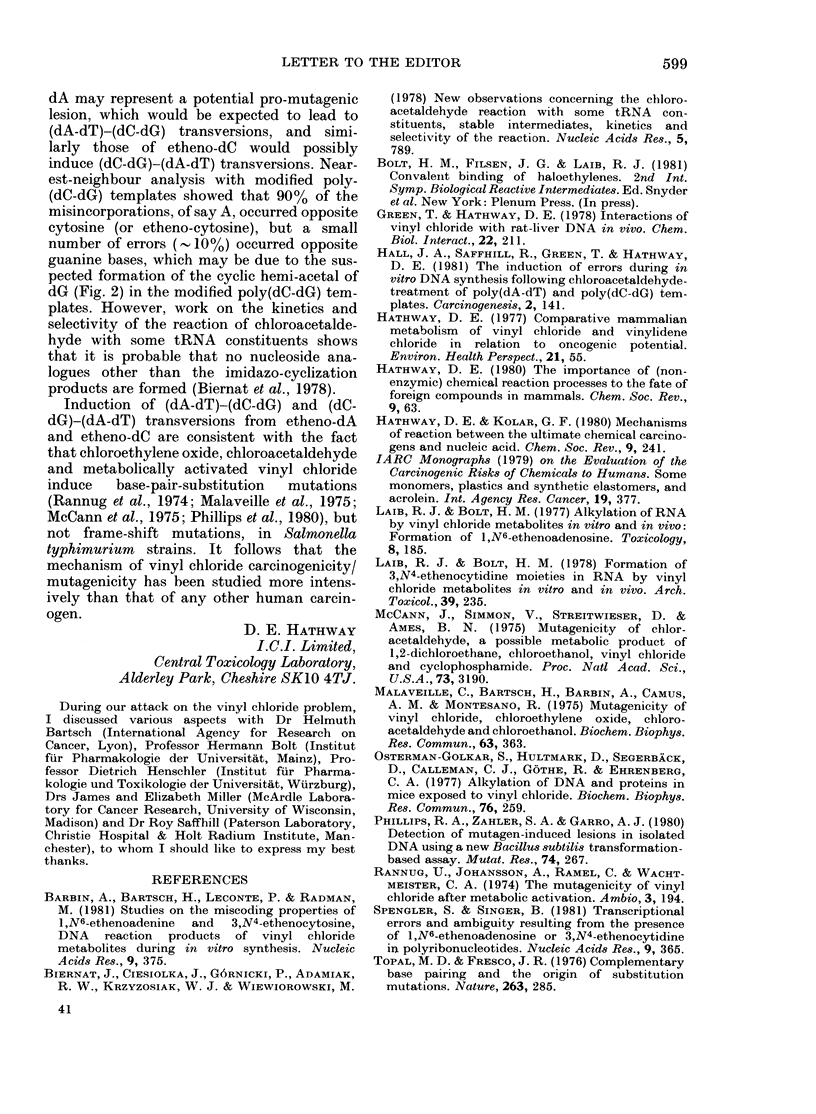Full text
PDF



Selected References
These references are in PubMed. This may not be the complete list of references from this article.
- Barbin A., Bartsch H., Leconte P., Radman M. Studies on the miscoding properties of 1,N6-ethenoadenine and 3,N4-ethenocytosine, DNA reaction products of vinyl chloride metabolites, during in vitro DNA synthesis. Nucleic Acids Res. 1981 Jan 24;9(2):375–387. doi: 10.1093/nar/9.2.375. [DOI] [PMC free article] [PubMed] [Google Scholar]
- Green T., Hathway D. E. Interactions of vinyl chloride with rat-liver DNA in vivo. Chem Biol Interact. 1978 Sep;22(2-3):211–224. doi: 10.1016/0009-2797(78)90126-6. [DOI] [PubMed] [Google Scholar]
- Hall J. A., Saffhill R., Green T., Hathway D. E. The induction of errors during in vitro DNA synthesis following chloroacetaldehyde-treatment of poly(dA-dT) and poly(dC-dG) templates. Carcinogenesis. 1981;2(2):141–146. doi: 10.1093/carcin/2.2.141. [DOI] [PubMed] [Google Scholar]
- Hathway D. E. Comparative mammalian metabolism of vinyl chloride and vinylidene chloride in relation to oncogenic potential. Environ Health Perspect. 1977 Dec;21:55–59. doi: 10.1289/ehp.772155. [DOI] [PMC free article] [PubMed] [Google Scholar]
- Laib R. J., Bolt H. M. Alkylation of RNA by vinyl chloride metabolites in vitro and in vivo: formation of 1-N(6)-etheno-adenosine. Toxicology. 1977 Oct;8(2):185–195. doi: 10.1016/0300-483x(77)90007-5. [DOI] [PubMed] [Google Scholar]
- Laib R. J., Bolt H. M. Formation of 3,N4-ethenocytidine moieties in RNA by vinyl chloride metabolities in vitro and in vivo. Arch Toxicol. 1978 Jan 25;39(3):235–240. doi: 10.1007/BF00368232. [DOI] [PubMed] [Google Scholar]
- Malaveille C., Bartsch H., Barbin A., Camus A. M., Montesano R., Croisy A., Jacquignon P. Mutagenicity of vinyl chloride, chloroethyleneoxide, chloroacetaldehyde and chloroethanol. Biochem Biophys Res Commun. 1975 Mar 17;63(2):363–370. doi: 10.1016/0006-291x(75)90697-x. [DOI] [PubMed] [Google Scholar]
- McCann J., Simmon V., Streitwieser D., Ames B. N. Mutagenicity of chloroacetaldehyde, a possible metabolic product of 1,2-dichloroethane (ethylene dichloride), chloroethanol (ethylene chlorohydrin), vinyl chloride, and cyclophosphamide. Proc Natl Acad Sci U S A. 1975 Aug;72(8):3190–3193. doi: 10.1073/pnas.72.8.3190. [DOI] [PMC free article] [PubMed] [Google Scholar]
- Osterman-Golkar S., Hultmark D., Segerbäck D., Calleman C. J., Göthe R., Ehrenberg L., Wachtmeister C. A. Alkylation of DNA and proteins in mice exposed to vinyl chloride. Biochem Biophys Res Commun. 1976 May 23;76(2):259–266. doi: 10.1016/0006-291x(77)90720-3. [DOI] [PubMed] [Google Scholar]
- Spengler S., Singer B. Transcriptional errors and ambiguity resulting from the presence of 1,N6-ethenoadenosine or 3,N4-ethenocytidine in polyribonucleotides. Nucleic Acids Res. 1981 Jan 24;9(2):365–373. doi: 10.1093/nar/9.2.365. [DOI] [PMC free article] [PubMed] [Google Scholar]
- Topal M. D., Fresco J. R. Complementary base pairing and the origin of substitution mutations. Nature. 1976 Sep 23;263(5575):285–289. doi: 10.1038/263285a0. [DOI] [PubMed] [Google Scholar]
- Wang A. H., Barrio J. R., Paul I. C. Crystal and molecular structure of 3,N4-ethenocytidine hydrochloride. A study of the dimensions and molecular interactions of the fluorescent epsilon-cytidine system. J Am Chem Soc. 1976 Nov 10;98(23):7401–7408. doi: 10.1021/ja00439a048. [DOI] [PubMed] [Google Scholar]
- Wang A. H., Dammann L. G., Barrio J. R., Paul I. C. The crystal and molecular structure of a derivative of 1,N6-ethenoadenosine hydrochloride. Dimensions and molecular interactions of the fluorescent epsilon-adenosine (epsilon-ado) system. J Am Chem Soc. 1974 Feb 20;96(4):1205–1212. doi: 10.1021/ja00811a038. [DOI] [PubMed] [Google Scholar]


